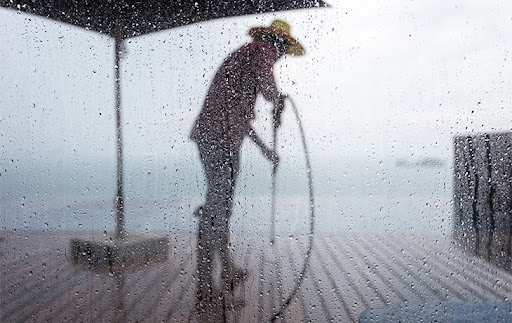
Rainy days and high humidity can be a hassle for many outdoor tasks — and pressure washing is no exception. But contrary to popular belief, you don’t always have to wait for a sunny day to get the job done. With the right approach, you can still clean safely and effectively in wet conditions. 💦👷♂️
Whether you’re a homeowner trying to squeeze in a weekend clean or a professional with a packed schedule, this guide will show you how to navigate rain, mist, and humidity like a pro — without sacrificing safety or results. 🌿⚡
🧠 Can You Pressure Wash in the Rain?
Yes — but with some caveats. While pressure washing during a light drizzle or humid conditions is generally safe (and sometimes helpful), heavy rain, lightning, or standing water are serious hazards and should always be avoided. ⚠️
Here’s a breakdown:
| Condition | Pressure Washing? |
|---|---|
| ☁️ Overcast skies | ✅ Safe |
| 🌧️ Light rain/drizzle | ✅ Generally OK with precautions |
| 🌧️ Heavy rain | ❌ Not recommended |
| ⛈️ Thunder/lightning | 🚫 Absolutely not — electrical hazard |
| 💦 High humidity | ✅ Safe, but slower drying |
🧽 Benefits of Pressure Washing in Wet or Humid Conditions
You might be surprised — working in a little rain or moisture can actually help in some cases:
✅ 1. Pre-soaking of Surfaces
Rain or mist acts like a natural pre-rinse, helping loosen dirt and debris before you start spraying.
✅ 2. Less Water Streaking
When everything is already damp, you’re less likely to see dry streaks or soap marks on siding or windows.
✅ 3. Cool Temperatures
Cool, humid air helps prevent cleaning solutions from drying too quickly, giving your detergents more time to work. 🧼
⚠️ Risks and What to Avoid
That said, there are real concerns when working in the rain or high humidity:
❌ Slip Hazards
Wet ground, steps, and sidewalks become slick fast. Always watch your footing and wear anti-slip shoes. 👟
❌ Reduced Visibility
Rain, mist, or fog can obscure your view of surfaces, leading to missed spots or uneven cleaning.
❌ Electrical Risk
If your pressure washer is electric, you must take extra precautions or avoid rain entirely. Water and electricity don’t mix. 🔌💧
❌ Longer Dry Times
Humidity slows evaporation — so surfaces like decks, concrete, or painted walls may take much longer to dry.
🧰 Tools and Equipment Tips for Wet Weather Washing
If you’re going to wash in the rain, you need to be prepared. Here are some gear tips:
🔌 Use Gas-Powered Equipment
Rain and electric cords are a dangerous combo. A gas-powered pressure washer is the safer option during wet weather. ⛽
🧤 Wear Waterproof Gear
Invest in waterproof gloves, boots, and a rain jacket. You’ll stay dry and comfortable, even in damp conditions.
🧼 Use the Right Detergents
Choose cleaners that are:
- Designed for outdoor use
- Effective in cold temperatures
- Formulated not to streak on wet surfaces
🧠 Pro Tip: Avoid bleach-based cleaners in heavy rain — they can wash away too quickly and lose effectiveness.
Browse Amazon Here For Top Rated Power Washers And Accessories
📏 Adjust Your Technique for Moisture
You’ll need to tweak your method slightly when dealing with wet or humid conditions:
➡️ 1. Apply Detergents from the Bottom Up
This prevents streaks and helps you spot areas you’ve missed. It also ensures better coverage during light rainfall. 🧼⬆️
➡️ 2. Rinse from the Top Down
Let gravity help you out — this ensures all dirt and soap is carried down and off the surface efficiently. ⬇️
➡️ 3. Increase Dwell Time
Because cleaners may be diluted slightly by rain, give them extra time to work before rinsing. Just don’t let them dry!
➡️ 4. Work in Smaller Sections
This keeps your workflow efficient and allows better control over cleaning and rinsing timing.
🧹 Humidity-Specific Challenges and Solutions
🌫️ Longer Dry Times
In high humidity, surfaces like wood, concrete, and paint can take hours longer to dry. To speed things up:
- Use a leaf blower or fan on stubborn areas
- Clean earlier in the day to allow for more drying time
- Avoid applying sealants or paints immediately after washing
🦠 Mold & Mildew Return Faster
Humidity creates the perfect conditions for mold to return quickly. Use anti-mildew solutions or post-cleaning treatments to slow regrowth.
🛑 When to Postpone
Don’t risk safety or poor results. You should reschedule your pressure washing if:
- There’s lightning in the area ⚡
- Your job site is flooded or ponding
- You’re using electrical tools that can’t be safely covered
- Visibility is too poor to see your work
Remember: no job is worth an injury or damaged property.
🧼 Final Thoughts
Pressure washing doesn’t always require sunny skies. With proper technique, safety gear, and attention to weather conditions, you can still tackle jobs in light rain or humid conditions — sometimes even more effectively than on dry days. ☁️💪
But stay smart: respect the risks, watch your equipment, and always prioritize safety. The grime will still be there tomorrow — and it’s better to clean confidently than carelessly.
So go ahead — grab your rain jacket, fire up that gas-powered washer, and wash like a pro. 🌧️🧽🌟
Browse Amazon Here For Top Rated Power Washers And Accessories



